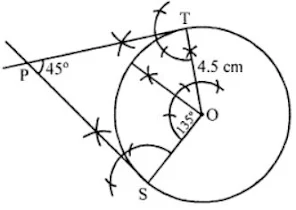RD Sharma Solutions Chapter 11 Constructions Exercise 11.3 Class 10 Maths

Chapter Name | RD Sharma Chapter 11 Constructions |
Book Name | RD Sharma Mathematics for Class 10 |
Other Exercises |
|
Related Study | NCERT Solutions for Class 10 Maths |
Exercise 11.3 Solutions
1. Draw a circle of radius 6 cm. From a point 10 cm away from its centre, construct the pair of tangents to the circle and measure their lengths.
Solution
Steps of construction :
- Draw a circle with O centre and 6 cm radius.
- Take a point P, 10 cm away from the centre O.
- Join PO and bisect it at M.
- With centre M and diameter PO, draw a circle intersecting the given circle at T and S.
- Join PT and PS.

2. Draw a circle of radius 3 cm. Take two points P and Q on one of its extended diameter each at a distance of 7 cm from its centre. Draw tangents to the circle from these two points P and Q.
Solution
Steps of construction :
- Draw a circle with centre O and radius 3 cm.
- Draw a diameter and produce it to both sides.
- Take two points P and Q on this diameter with a distance of 7 cm each from the centre O.
- Bisect PO at M and QO at N
- With centres M and N, draw circle on PO and QO as diameter which intersect the given circle at S, T and S', T' respectively.
- Join PS, PT, QS' and QT'.

3. Draw a line segment AB of length 8 cm. Taking A as centre, draw a circle of radius 4 cm and taking B as centre, draw another circle of radius 3 cm. Construct tangents to each circle from the centre of the other circle.
Solution
Steps of construction :
- Draw a line segment AB = 8 cm.
- With centre A and radius 4 cm and with centre B and radius 3 cm, circles are drawn.
- Bisect AB at M.
- With centre M and diameter AB, draw a circle which intersects the two circles at S', T' and S, T respectively.
- Join AS, AT, BS' and BT'.
Then AS, AT, BS' and BT' are the required tangent.
4. Draw two tangents to a circle of radius 3.5 cm from a point P at a distance of 6.2 cm from its centre.
Solution
Steps of construction :
- Draw a circle with centre O and radius 3.5 cm
- Take a point P which is 6.2 cm from O.
- Bisect PO at M and draw a circle with centre M and diameter OP which intersects the given circle at T and S respectively.
- Join PT and PS.

5. Draw a pair of tangents to a circle of radius 4.5 cm, which are inclined to each other at an angle of 45°.
Solution
Steps of construction :
Angle at the centre 180° – 45° = 135°
(i) Draw a circle with centre O and radius 4.5 cm.
(ii) At O, draw an angle ∠TOS = 135°
(iii) At T and S draw perpendicular which meet each other at P.
PT and PS are the tangents which inclined each other 45°.
6. Draw a right triangle ABC in which AB = 6 cm, BC = 8 cm and ∠B = 90°. Draw BD perpendicular from B on AC and draw a circle passing through the points B, C and D. Construct tangents from A to this circle.
Solution
Steps of Construction :
- Draw a line segment BC = 8 cm
- From B draw an angle of 90°
- Draw an arc BA = 6cm cutting the angle at A.
- Join AC.
- ΔABC is the required A.
- Draw ⊥ bisector of BC cutting BC at M.
- Take M as centre and BM as radius, draw a circle.
- Take A as centre and AB as radius draw an arc cutting the circle at E. Join AE.
Justification :
∠ABC = 90° (Given)
Since, OB is a radius of the circle.
∴ AB is a tangent to the circle.
Also, AE is a tangent to the circle.

7. Draw two concentric circles of radii 3 cm and 5 cm. Construct a tangent to the smaller circle from a point on the larger circle. Also, measure its length.
Solution
Given, two concentric circles of radii 3 cm and 5 cm with centre O. We have to draw pair of tangents from point P on outer circle to the other.
Steps of construction :
- Draw two concentric circles with centre O and radii 3 cm and 5 cm.
- Taking any point P on outer circle. Join OP.
- Bisect OP, let M' be the mid-point of OP.
- Taking M' as centre and OM' as radius draw a circle dotted which cuts the inner circle as M and P'.
- Join PM and PP’. Thus, PM and PP’ are the required tangents.
- On measuring PM and PP', we find that PM = PP' = 4 cm.
In right angle ΔOMP, ∠PMO = 90°
∴ PM2 = OP2 – OM2
[by Pythagoras theorem i.e. (hypotenuse)2 = (base)2 + (perpendicular)2]
⇒ PM2 = (5)2 – (3)2 = 25 – 9 = 16
⇒ PM = 4 cm
Hence, the length of both tangents is 4 cm.



